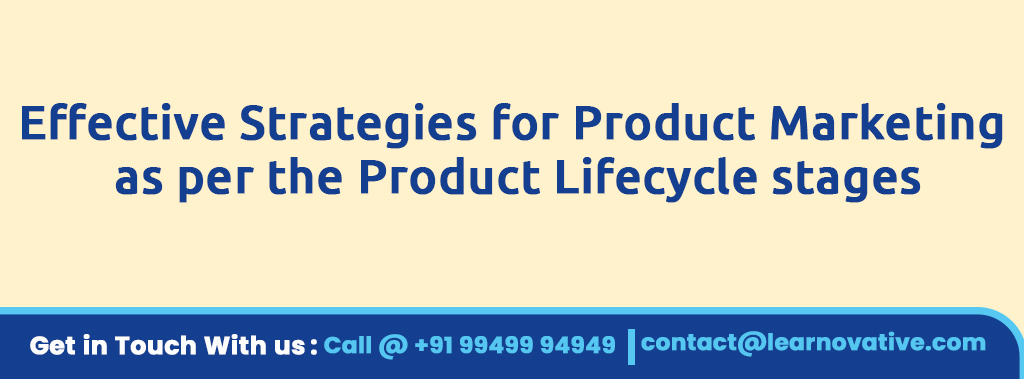
Effective product marketing strategies vary significantly depending on the stage of the product lifecycle. The product lifecycle stages typically include Idea, Creation, Introduction, Growth, Maturity, and Decline (Retire). Introduction, Growth, Maturity and Retire stages will need various strategies in order to make maximum profit and ensure the Product exists in the market for longer duration. Here’s how marketing strategies can be tailored to each stage:
1.Introduction Stage
Objective:
- Create awareness and generate initial demand.
Strategies:
- Market Education and Awareness:
- Invest in marketing campaigns to educate potential customers about the product. Use online ads, social media, content marketing, and PR to spread the word.
- Attend trade shows, webinars, and industry events to showcase the product.
- Focus on Early Adopters:
- Identify and target early adopters who are more likely to try new products. Offer incentives such as discounts or exclusive access.
- Build Brand and Product Identity:
- Develop a strong brand identity and clear value proposition. Ensure that all marketing materials convey the product’s benefits and unique features.
- Leverage Influencers and Thought Leaders:
- Collaborate with industry influencers and thought leaders to endorse the product and build credibility.
- Provide Excellent Customer Support:
- Offer robust customer support to assist early users and gather feedback for improvements.
- Market Education and Awareness:
- Rapid skimming:
- In this approach you will introduce the Product with HIGH price and also HIGH promotional expenses. Purpose of high price is to revolver product profit as early as possible. High promotional cost is to attract and convince the market and justify the product’s high price. High promotion accelerates the rate of market penetration. You will use this approach when the major part of the market is not aware of the product and customers are ready to pay a high price.
- Slow skimming strategy:
- In this approach you will introduce the product with HIGH price with LOW promotional expenses. The purpose of a high price is to recover profit faster. You will use this in case of a limited market size and most of the customers are aware of the product. Also the customers are ready to pay the high price and low competition for your product.
- Rapid penetration:
- In this approach you will introduce the product with LOW price and HIGH promotional expenses. You will use this when the product needs to get faster market penetration to get a large market share. You will use this approach in a Large market, People are price sensitive, large competition and profits are possible with low price with high volume of sales.
- Slow penetration:
- In this approach the product is launched with LOW price and LOW promotional expenses. Low price encourages quick product acceptance and low promotions can help realizing more profits. You will use this approach when market is large, people are aware of the product, low competition and buyers are price sensitive.
2. Growth Stage
Objective:
- Expand market share and scale the customer base.
Strategies:
- Expand Distribution Channels:
- Increase the number of distribution channels and partners to make the product more accessible.
- Enhance Product Features:
- Continuously improve the product based on customer feedback and market trends. Highlight these enhancements in marketing campaigns.
- Invest in Branding and Differentiation:
- Strengthen brand positioning and differentiate the product from competitors. Use comparative advertising to highlight advantages.
- Aggressive Marketing Campaigns:
- Increase marketing efforts through digital marketing, TV, radio, print ads, and social media to reach a wider audience.
- Customer Testimonials and Case Studies:
- Showcase success stories and testimonials from satisfied customers to build trust and attract new users.
- Loyalty Programs and Referrals:
- Implement loyalty programs and referral incentives to encourage repeat purchases and word-of-mouth promotion.
3. Maturity Stage
Objective:
- Maximize profit and defend market position.
Strategies:
- Optimize Pricing:
- Consider competitive pricing strategies such as discounts, bundling, or premium pricing for advanced features.
- Diversify Product Offerings:
- Introduce product variations, enhancements, or complementary products to cater to different market segments and refresh interest.
- Increase Efficiency:
- Focus on cost reduction and process optimization to maintain profitability.
- Strengthen Customer Relationships:
- Enhance customer engagement through personalized marketing, loyalty programs, and excellent customer service.
- Expand to New Markets:
- Explore new geographic or demographic markets to sustain growth.
- Defensive Marketing:
- Protect market share by reinforcing brand loyalty and countering competitive threats through strategic marketing campaigns.
4. Decline Stage
Objective:
- Maximize remaining value and decide on product phase-out strategy.
Strategies:
- Harvesting:
- Reduce marketing and production costs to maximize remaining profits. Focus on the most profitable customer segments.
- Product Updates and Rejuvenation:
- Consider revitalizing the product with new features, rebranding, or targeting new uses to extend its lifecycle.
- Discontinue or Divest:
- If rejuvenation isn’t viable, gradually phase out the product. Communicate clearly with customers and provide transition support if necessary.
- Promotions and Clearance:
- Use promotions and clearance sales to liquidate remaining inventory.
- Focus on Core Products:
- Shift focus and resources to more profitable or promising products in the portfolio.
Conclusion
Effective product marketing requires adapting strategies to the specific needs and dynamics of each product lifecycle stage. By understanding and responding to these stages with targeted marketing efforts, companies can optimize their product’s success and longevity in the market.
Boost your career with Advanced Certified Scrum Product Owner training in hyderabad! Get certified and enhance your skills in leading teams, managing projects, and driving business success. Join the best ACSPO course online training in hyderabad and unlock the secrets of Agile project management. Enroll now and take the first step towards becoming a certified Scrum professional. Our advanced certified Scrum product owner course online in hyderabad offers interactive sessions, real-world case studies, and expert instructors to help you master the Scrum framework.
